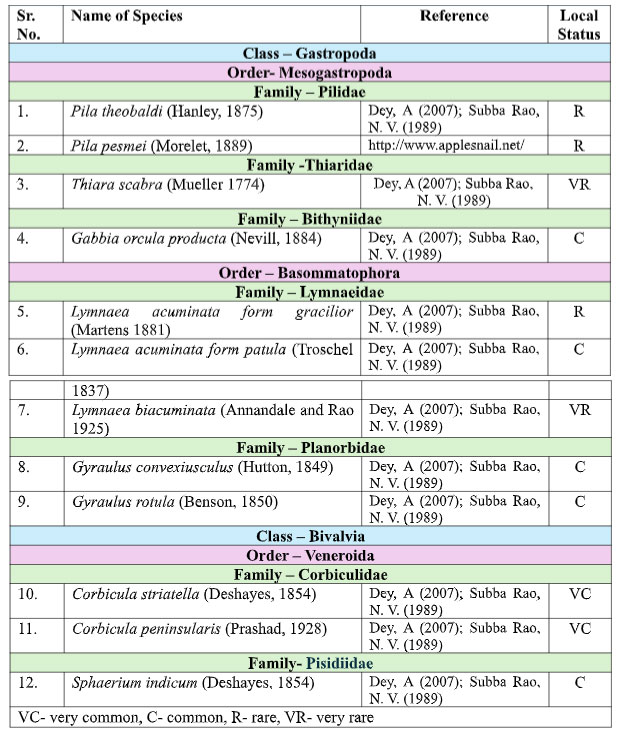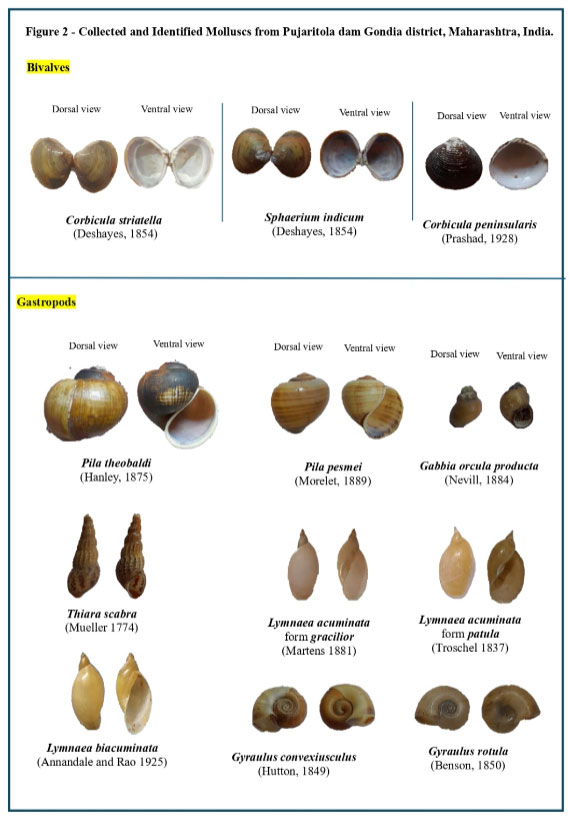1Department of Zoology, Shankarlal Agrawal Science College Salekasa, Dist. Gondia, Maharashtra.
2Department of Zoology, Shri. Dr. R. G. Rathod Arts and Science College Murtizapur Dist. Akola, Maharashtra.
Article Publishing HistoryReceived: 10/07/2024
Accepted After Revision: 25/09/2024
ABSTRACT:Freshwater molluscs are of the important components of aquatic ecosystem which help in maintaining the balance and cleanliness of aquatic environments. Some gastropods serve as intermediate host to transfer helminthic infections. This survey was carried out to study diversity of freshwater malacofauna of Gondia region from Maharshtra India. Survey was done by visual searching across the banks of Pujaritola dam. Molluscan shells were collected by hand picking method. Species identification was carried out using standard references. Total 12 species of molluscs have been reported in this paper, 9 of these are gastropods and 3 are bivalves. These species belong to 3 orders, 7 families and 7 genera.
Gastropod species recorded were Pila theobaldi, Pila pesmei, Gabbia orcula producta, Thiara scabra, Lymnaea acuminata form gracilior, Lymnaea acuminata form patula, Lymnaea biacuminata, Gyraulus convexiusculus, and Gyraulus rotula. Bivalves found at site were Corbicula striatella, Corbicula peninsularis and Sphaerium indicum. Lymnaea biacuminata was rarest species at this site followed by Pila theobaldi, Pila pesmei, Lymnaea acuminata form gracilior. This study will contribute to carry out further investigations on the freshwater malacofauna’s occurrence in this area as well as its analysis of distribution and richness. Three new species that had not before been documented in Maharashtra have been found during this survey. Understanding the region’s molluscan species—both edible and harmful—will be aided by this inventory. This work will form the basis of further research in this area. There is further scope of research in implications in other field such as, food, disease transmissions and medicine.
KEYWORDS:Freshwater malacofauna, gastropods, bivalves, Pujaritola dam, Gondia district.
Download this article as: Copy the following to cite this article:Ade G. V, Makode P. M. Enlisting of some Molluscan Species from Pujaritola Dam of Gondia Maharashtra, India. Biosc.Biotech.Res.Comm. 2024;17(3).
Copy the following to cite this URL:Ade G. V, Makode P. M. Enlisting of some Molluscan Species from Pujaritola Dam of Gondia Maharashtra, India. Biosc.Biotech.Res.Comm. 2024;17(3). Available from: <a href=”https://shorturl.at/jzB9J“>https://shorturl.at/jzB9J</a>
INTRODUCTION
Phylum Mollusca is the second largest phylum after Arthropoda. Most molluscs are marine, with a small number of freshwater and some terrestrial species. After migrating from the ocean to freshwater, molluscs eventually arrived in terrestrial environments (Dey, 2007). Except Antarctica, freshwater molluscs are found all over the world. Freshwater molluscs are divided into class Gastropoda and class Bivalvia. In gastropods soft body is enclosed in a single, spirally coiled shell. In bivalves soft body is enclosed in two parts of shells which are hinged together at dorsal side by ligament. Morphological characters of shells in molluscs shows different characters that help in their taxonomical identification. Freshwater molluscs are very essential in aquatic ecosystem and have significant impact on biogeochemical cycle (Tripathy and Mukhopadhayay, 2015).
Molluscs play important role in food chain, and they keep water clean by filter feeding mechanism (Dey 2008). Molluscs have great economic importance in food, freshwater pearl culture production, as medicines and various shell uses. Some freshwater molluscs acts as intermediate hosts for many trematode worms causing diseases in man, cattle, sheep, monkey, goat (Gadgil and Shah 1955; Mukherjee and Chauhan 1965). Various investigators do important work in documenting malacofauna throughout India. The Zoological Survey of India contributed great in this area.
Diversity surveys have been done over the recent years in various regions of India by Pasupuleti and Subba Rao (2014), Sajan et al (2014), Kumar et al (2019), Rekha et al., (2021), Chutia and Kardong, (2021), Jadhav et al., (2023). Patil (2005) which have been carried out on freshwater molluscs in Melghat Tiger Reserve. In Nagpur region, Dorlikar, et al. (2014) and Wagh et al., (2019) have carried out investigations in Amravati region, where they have worked on freshwater molluscan diversity. There is no previously conducted research on molluscan diversity in Gondia, hence the current study deals with the description of molluscans from Pujaritola dam of Gondia Maharashtra India .
MATERIALS AND METHODS
Study area: Gondia district is in the north-eastern part of Maharashtra. Madhya Pradesh surrounds Gondia to the north and Chhattisgarh to the east. It lies at latitudes 20.39 and 21.380 North and longitudes 79.27 to 80.420 east. The district occupies an area of 5,234 km2. Gondia has extremely high summer temperatures and extremely low winter temperatures. During each rainy season the average recorded rainfall is over 1,200 mm. Its average relative humidity is 62 percent. The highest recorded temperature in May is 480 C and lowest in January 00 C.
Pujaritola dam also called as Kotra dam, is built across the Bagh River having earth fill construction, with main objective of irrigation. It is near Amgaon at 21.212119840 N latitude and 80.42404180 E longitude. Height of dam is 19.2 meter and length is 2,661 meters.
Figure 1: The Map of Gondia District Showing Pujaritola dam.

FIELD SAMPLING: Field sampling was done for six months from September-2023 to February-2024. Survey was done by visual searching across the banks of Pujaritola dam. Molluscan shells are collected by hand picking method from littoral zone of water body. Shells lodged in aquatic plants and weeds were collected by scoop net, forceps. Ony molluscan shells were collected for analysis. Live molluscs were observed only at site and were promptly released back in water bodies.
Collected molluscan shells were safely brought in polythene bags and plastic boxes to avoid breakage. They were washed properly with soft brush under tap water to remove dirt and were dried. Species identification was done by using standard keys of Subba Rao (1989), Ramkrishna and Dey (2007), and some of the recent research papers. Quantification of malacofauna was done by random quadrant method (Christian and Harris 2005). Quadrat used was 0.5 m length having 25 small square each square of 10 cm.
RESULTS AND DISCUSSION

Total 12 species of mollusks were reported in this paper 9 of these are gastropods and three are bivalves. These species belong to 3 orders , 7 families and 7 genera as shown in (Table-1). Gastropod species recorded were Pila theobaldi, Pila pesmei, Gabbia orcula producta, Thiara scabra, Lymnaea acuminata form gracilior, Lymnaea acuminata form patula, Lymnaea biacuminata, Gyraulus convexiusculus, and Gyraulus rotula. Corbicula striatella, Corbicula peninsularis, Sphaerium indicum were bivalve species recorded from site (Figure 2).
Among these Sphaerium indicum , Corbicula striatella and Corbicula peninsularis were very commonly found species. Gabbia orcula producta, Lymnaea acuminata form patula, Gyraulus convexiusculus, Gyraulus rotula and Sphaerium indicum were common species at the site. Pila theobaldi, Pila pesmei, Lymnaea acuminata form gracilior were rare whereas Thiara scabra and Lymnaea biacuminata were very rarely recorded from Pujaritola dam. Pila theobaldi is used as food (Tripathy and Mukhopadhayay, 2015). Gyraulus convexiusculus is pathogenic species carried helminthic infection in man and pig (Mukherjee and Chauhan 1965).

CONCLUSION
This study will contribute to the investigation of the freshwater malacofauna’s occurrence in this area as well as its analysis of distribution and richness. Three new species that had not before been documented in Maharashtra are found during this survey. Understanding the region’s molluscan species—both edible and harmful—will be aided by this inventory. This work will form the basis of further research in this area. There is further scope of research in implications in other field such as, food, disease transmissions and medicine.
Conflict of interest: Authors declare no conflict of interest
REFERENCES
Choubisa, S.L., (1992). Molluscs as bio-indicators for the trophic stages of lakes and lotic environments. Bulletin of Pure and Applied Science, 11, pp.35-40.
Christian, A.D. and Harris, J.L., (2005) Development and assessment of a sampling design for mussel assemblages in large streams. The American midland naturalist, 153(2), pp.284-292.
Chutia, J. and Kardong, D., 2021. Current status and seasonal distribution of malacofaunal assemblage in Poba Reserve Forest in relation to certain physico-chemical parameters. Asian Journal of Biological and Life Sciences, 10(1), pp.93-100.
Dey, A. (2008). Commercial and medicinal important molluscs of Sundarbans, India. Records of the zoological survey of India, Occasional Paper, 286, 1-54.
Dey, A., (2007). Handbook on Indian freshwater molluscs. AICOPTAX–Mollusca, Zoological Survey of India.
Dorlikar, A.V., Mohite, A.S. and Charde, P.N.,(2014). Correlation of molluscan diversity with physicochemical characteristics of water of Gorewada reservoir, Nagpur, India. International Journal of Life Sciences, Special Issue A, 2, pp.197-201.
Gadgil, R.K. and Shah, S.N., (1954). Human schistosomiasis in India. Discovery of an endemic focus and a new snail host in Bombay State.
Gondia Gazetteer (2021). Database of Gondia District redirected from official website of Gondia District (M.S.), India, www.gondia.nic.in.
Jadhav, A., Das, N.K., Sil, M. and Neelavara Ananthram, A., (2023). Snails on the plate: Edible freshwater molluscs of Northeast India. Indian Journal of Traditional Knowledge (IJTK), 22(2), pp.409-419.
Kamble, V.S., (2018). Study of diversity of freshwater molluscs from drought prone region Sangola, district Solapur (MS), India. J Emerg Technol Innov Res, 5(8).
Kumar, R. and Maansi, W.M., (2019). Molluscan Biodiversity and its seasonal fluctuations in Teekar Taal, Haryana. Indian International Journal of Research-Granthalayah, 7(1), pp.169-178.
Kumar, R. and Maansi, W.M., (2019). Molluscan Biodiversity and its seasonal fluctuations in Teekar Taal, Haryana. Indian International Journal of Research-Granthalayah, 7(1), pp.169-178.
Mukherjee, R.P. and Chauhan, B.S., (1967). Studies on the trematode fauna of India. Part V. Subclass Digenea: Paramphisto-midae Fischoeder (1901).
Patil, S.G. (2005). Freshwater Mollusca of Melghat Tiger Project Maharashtra State. Fauna of Conservation area series, Zoological Survey of India Publication.
Rekha, K., Anbalagan, S. and Dinakaran, S., 2021. Distributional ecology of snails (Gastropoda: Mollusca) in seasonal ponds of Tamil Nadu, South India. Acta Ecologica Sinica, 41(5), pp.410-415.
Sajan, S., Tripathy, B., Chandra, K. and Sivakumar, K., (2019). Rediscovery and re-description of Rhaphaulus assamicus Godwin-Austen, 1886, an endemic pupinid land snail from India (Gastropoda: Pupinidae). Journal of Natural History, 53(41-42), pp.2553-2562.
Subba Rao, N.V., 1989. Handbook, freshwater molluscs of India.
Tripathy, B. and Mukhopadhayay, A., (2015). Freshwater molluscs of India: an insight of into their diversity, distribution and conservation. Aquatic Ecosystem: Biodiversity, Ecology and Conservation, pp.163-195.
Wagh, G.A., Qureshi, H.A. and Patil, S.R., (2019). A brief note on molluscan diversity from water bodies of Amravati MS India. Bioscience Biotechnology Research Communications, 12 (3), pp.814-819.
留言 (0)